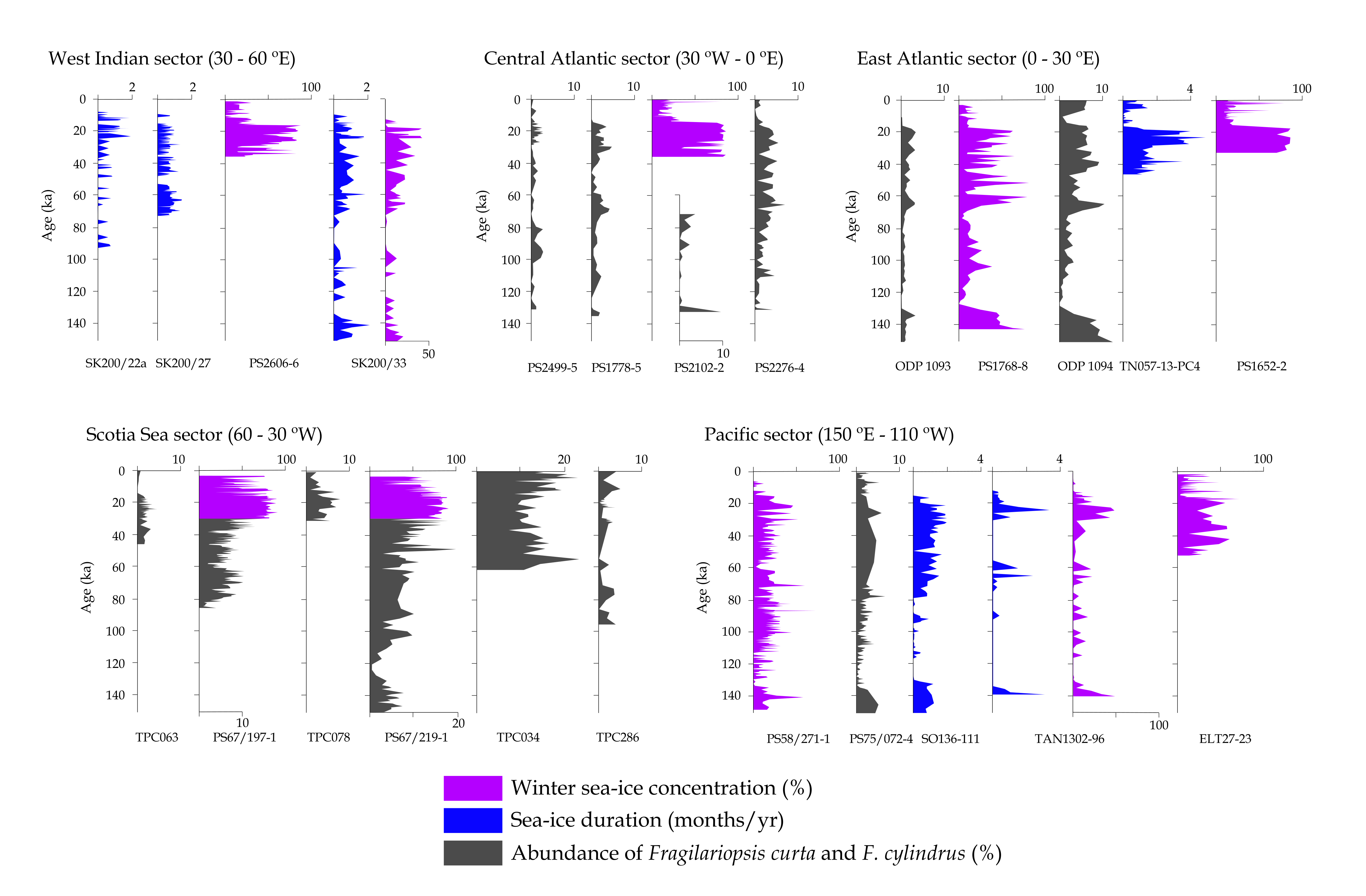- Home
- Publications
- PAGES Magazine
- The Second Phase of The Cycle of Sea-Ice Dynamics In The Earth System (C-SIDE) Working Group
The second phase of the Cycle of Sea-Ice Dynamics in the Earth System (C-SIDE) working group
Chadwick M, Kohfeld KE, Bostock H, Crosta X, Leventer A and Meissner K
Past Global Changes Magazine
30(1)
53
2022
M. Chadwick1, K.E. Kohfeld2, H. Bostock3, X. Crosta4, A. Leventer5 and K. Meissner6
Antarctic sea ice plays several crucial roles within the Earth system. The sea-ice seasonal cycle influences atmospheric dynamics (heat and air-sea gas exchanges; Rysgaard et al. 2011) and affects the circulation of heat, salt, and nutrients within the ocean (Maksym 2019). On glacial–interglacial timescales, sea ice has been proposed as an important player in modulating changes in atmospheric carbon dioxide concentration (Kohfeld and Chase 2017). Our understanding of the role of sea ice within this system is dependent on our ability to reconstruct and model past sea-ice changes, as well as to reconstruct and model complementary changes within the Earth and climate system.
The Cycles of Sea-Ice Dynamics in the Earth System (C-SIDE; pastglobalchanges.org/c-side) working group was established in 2018 to synthesize existing sea-ice records from the Southern Ocean over the past 130,000 years. The main objective of C-SIDE is to better understand how changes in sea ice were related to other important oceanic processes, and to examine more closely how sea ice is simulated in Earth system model simulations of the last glacial period. Our choice of this timescale was selected so that we could evaluate sea-ice dynamics during previous warm periods (e.g. the Last Interglacial Period when Antarctica was 2ºC warmer than today), warming glacial-to-interglacial transitions, and the major cooling periods of glacial inception, during which ocean carbon uptake was substantial.
During our first three years, the C-SIDE group held two workshops with the sea-ice community, which helped us to establish research priorities and outline the scope of our efforts. We assembled a comprehensive inventory of Southern Ocean sea-ice records covering at least a part of the time interval between 130,000 years ago and the Holocene. From this inventory, we identified 24 sites with high-resolution and long-duration sea-ice records for the last glacial-interglacial cycle (Fig. 1; Chadwick et al. 2022b). These data have been submitted to the PANGAEA database, and the paper has been submitted as part of a special issue that we organized for Climate of the Past entitled "Reconstructing Southern Ocean sea-ice dynamics on glacial-to-historical timescales". This special issue will be accepting topical submissions until December 2022. In addition to the sea-ice compilation, this special issue includes articles presenting new Southern Ocean sea-ice reconstructions (Chadwick et al. 2022a; Jones et al. 2022), as well as articles discussing developments in novel Antarctic sea-ice proxies (Lamping et al. 2021; McClymont et al. 2022; Vorrath et al. 2020). It also contains articles evaluating the processes controlling sea-ice distribution and deep-ocean circulation in simulations of the last glacial maximum, using climate models from the Paleoclimate Modelling Intercomparison Project PMIP3 and PMIP4, and iLOVECLIM (Lhardy et al. 2021; Green et al. 2020).
The second phase of the working group is already brimming with activities. Two review papers are nearing completion and will address, firstly, the use of a range of proxies for reconstructing sea ice during the last 130,000 years and, secondly, the current state of our understanding of how sea ice is linked with atmospheric, oceanic, land ice, and biogeochemical processes on glacial–interglacial timescales. With the help of funds from Simon Fraser University (SFU) and the Canadian Mitacs program, C-SIDE members will be hosting three early-career researchers at SFU to bring together complementary datasets (sea-surface and subsurface temperature records reconstructed using radiolarian proxies) to examine temporal relationships between sea-ice changes and ocean temperature and water mass behavior in the Southern Ocean. C-SIDE is also collaborating with the leaders of the Arctic Cryosphere Change and Coastal Marine Ecosystems (ACME; pastglobalchanges.org/acme) working group to produce a PAGES Magazine issue on sea-ice changes at both poles to be published in the second half of 2022. Finally, as international travel possibilities re-emerge, the C-SIDE steering committee is looking into opportunities to reschedule our third, postponed, workshop, to focus our ongoing efforts within the global sea-ice and PAGES communities.
affiliationS
1British Antarctic Survey, Cambridge, UK
2School of Resource and Environmental Management and School of Environmental Science, Simon Fraser University, Burnaby, BC, Canada
3School of Earth and Environmental Sciences, University of Queensland, Brisbane, Australia
4University of Bordeaux, France
5Department of Geology, Colgate University, Hamilton, NY, USA
6Climate Change Research Centre, University of New South Wales, Sydney, Australia
contact
Karen Kohfeld: kohfeld sfu.ca
sfu.ca
references
Chadwick M et al. (2022a) Clim Past 18: 129-146
Chadwick M et al. (2022b) Clim Past Discuss, doi:10.5194/cp-2022-15
Green RA et al. (2020) Clim Past Discuss, doi:10.5194/cp-2020-155
Jones J et al. (2022) Clim Past 18: 465-482
Kohfeld KE, Chase Z (2017) Earth Planet Sci Lett 472: 206-215
Lamping N et al. (2021) Clim Past 17: 2305-2326
Lhardy F et al. (2021) Clim Past 17: 1139-1159
Maksym T (2019) Ann Rev Mar Sci 11: 187-213
McClymont EL et al. (2022) Clim Past 18: 381-403
Rysgaard S et al. (2011) Tellus B Chem Phys Meteorol 63: 823-830

